Related Research Articles
Infrared astronomy is a sub-discipline of astronomy which specializes in the observation and analysis of astronomical objects using infrared (IR) radiation. The wavelength of infrared light ranges from 0.75 to 300 micrometers, and falls in between visible radiation, which ranges from 380 to 750 nanometers, and submillimeter waves.

The Orion Nebula is a diffuse nebula situated in the Milky Way, being south of Orion's Belt in the constellation of Orion,[b] and is known as the middle "star" in the "sword" of Orion. It is one of the brightest nebulae and is visible to the naked eye in the night sky with an apparent magnitude of 4.0. It is 1,344 ± 20 light-years (412.1 ± 6.1 pc) away and is the closest region of massive star formation to Earth. The M42 nebula is estimated to be 24 light-years across. It has a mass of about 2,000 times that of the Sun. Older texts frequently refer to the Orion Nebula as the Great Nebula in Orion or the Great Orion Nebula.

NGC 2264 is the designation number of the New General Catalogue that identifies two astronomical objects as a single object: the Cone Nebula, and the Christmas Tree Cluster. Two other objects are within this designation but not officially included, the Snowflake Cluster, and the Fox Fur Nebula. All of the objects are located in the Monoceros constellation and are located about 720 parsecs or 2,300 light-years from Earth. Due to its relative proximity and large size, it is extremely well-studied. NGC 2264 is sometimes referred to as the Christmas Tree Cluster and the Cone Nebula. However, the designation of NGC 2264 in the New General Catalogue refers to both objects and not the cluster alone.

A proplyd, short for ionized protoplanetary disk, is an externally illuminated photoevaporating protoplanetary disk around a young star. Nearly 180 proplyds have been discovered in the Orion Nebula. Images of proplyds in other star-forming regions are rare, while Orion is the only region with a large known sample due to its relative proximity to Earth.

NGC 604 is an H II region inside the Triangulum Galaxy. It was discovered by William Herschel on September 11, 1784. It is among the largest H II regions in the Local Group of galaxies; at the galaxy's estimated distance of 2.7 million light-years, its longest diameter is roughly 1,520 light years (~460 parsecs), over 40 times the size of the visible portion of the Orion Nebula. It is over 6,300 times more luminous than the Orion Nebula, and if it were at the same distance it would outshine Venus. Its gas is ionized by a cluster of massive stars at its center with 200 stars of spectral type O and WR, a mass of 105 solar masses, and an age of 3.5 million years; however, unlike the Large Magellanic Cloud's Tarantula Nebula central cluster (R136), NGC 604's one is much less compact and more similar to a large stellar association.
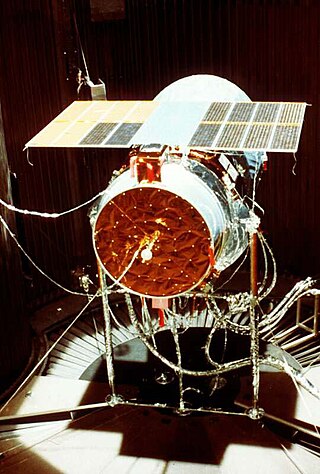
The Infrared Astronomical Satellite (IRAS) was the first space telescope to perform a survey of the entire night sky at infrared wavelengths. Launched on 25 January 1983, its mission lasted ten months. The telescope was a joint project of the United States (NASA), the Netherlands (NIVR), and the United Kingdom (SERC). Over 250,000 infrared sources were observed at 12, 25, 60, and 100 micrometer wavelengths.
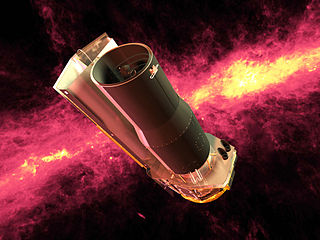
The Spitzer Space Telescope, formerly the Space Infrared Telescope Facility (SIRTF), was an infrared space telescope launched in 2003, that was deactivated when operations ended on 30 January 2020. Spitzer was the third space telescope dedicated to infrared astronomy, following IRAS (1983) and ISO (1995–1998). It was the first spacecraft to use an Earth-trailing orbit, later used by the Kepler planet-finder.

The Eagle Nebula is a young open cluster of stars in the constellation Serpens, discovered by Jean-Philippe de Cheseaux in 1745–46. Both the "Eagle" and the "Star Queen" refer to visual impressions of the dark silhouette near the center of the nebula, an area made famous as the "Pillars of Creation" imaged by the Hubble Space Telescope. The nebula contains several active star-forming gas and dust regions, including the aforementioned Pillars of Creation. The Eagle Nebula lies in the Sagittarius Arm of the Milky Way.
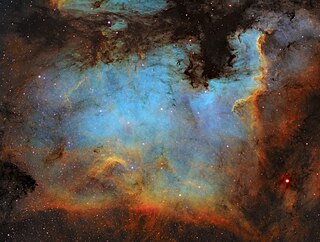
The North America Nebula is an emission nebula in the constellation Cygnus, close to Deneb. It is named because its shape resembles North America.
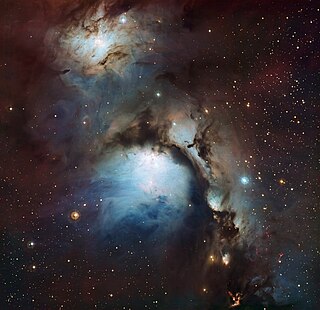
Messier 78 or M78, also known as NGC 2068, is a reflection nebula in the constellation Orion. It was discovered by Pierre Méchain in 1780 and included by Charles Messier in his catalog of comet-like objects that same year.

Sh 2-279 is an HII region and bright nebulae that includes a reflection nebula located in the constellation Orion. It is the northernmost part of the asterism known as Orion's Sword, lying 0.6° north of the Orion Nebula. The reflection nebula embedded in Sh 2-279 is popularly known as the Running Man Nebula.

The Infrared Processing and Analysis Center (IPAC) provides science operations, data management, data archives and community support for astronomy and planetary science missions. IPAC has a historical emphasis on infrared-submillimeter astronomy and exoplanet science. IPAC has supported NASA, NSF and privately funded projects and missions. It is located on the campus of the California Institute of Technology in Pasadena, California.
Doris Daou is a Lebanese-born Canadian-American astronomer who was formerly the Director for Education and Public Outreach of the NASA Lunar Science Institute and the associate director of the NASA Solar System Exploration Research Virtual Institute (SSERVI), and is currently the program contact for NASA's "Small Innovative Missions for Planetary Exploration (SIMPLEx)".
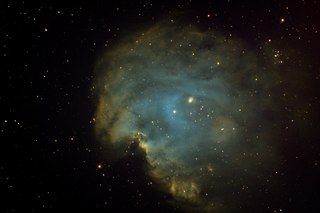
NGC 2174 is an H II emission nebula located in the constellation Orion and is associated with the open star cluster NGC 2175. It was discovered on 6 February 1877 by French astronomer Édouard Stephan. It is thought to be located about 6,400 light-years away from Earth. The nebula may have formed through hierarchical collapse.
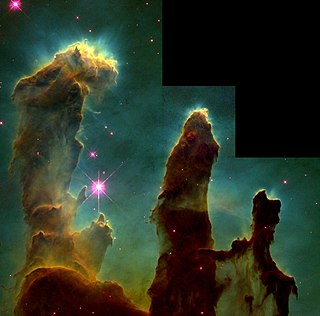
Pillars of Creation is a photograph taken by the Hubble Space Telescope of elephant trunks of interstellar gas and dust in the Eagle Nebula, in the Serpens constellation, some 6,500–7,000 light-years from Earth. These elephant trunks had been discovered by John Charles Duncan in 1920 on a plate made with the Mount Wilson Observatory 60-inch telescope. They are so named because the gas and dust are in the process of creating new stars, while also being eroded by the light from nearby stars that have recently formed.

NGC 1333 is a reflection nebula located in the northern constellation Perseus, positioned next to the southern constellation border with Taurus and Aries. It was first discovered by German astronomer Eduard Schönfeld in 1855. The nebula is visible as a hazy patch in a small telescope, while a larger aperture will show a pair of dark nebulae designated Barnard 1 and Barnard 2. It is associated with a dark cloud L1450. Estimates of the distance to this nebula range from 980–1,140 ly (300–350 pc).

IC 5146 is a reflection/emission nebula and Caldwell object in the constellation Cygnus. The NGC description refers to IC 5146 as a cluster of 9.5 mag stars involved in a bright and dark nebula. The cluster is also known as Collinder 470. It shines at magnitude +10.0/+9.3/+7.2. Its celestial coordinates are RA 21h 53.5m, dec +47° 16′. It is located near the naked-eye star Pi Cygni, the open cluster NGC 7209 in Lacerta, and the bright open cluster M39. The cluster is about 4,000 ly away, and the central star that lights it formed about 100,000 years ago; the nebula is about 12 arcmins across, which is equivalent to a span of 15 light years.
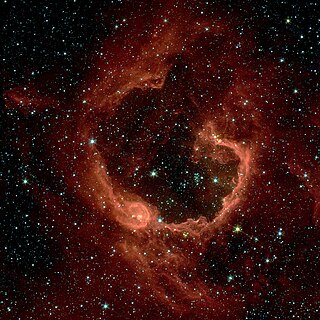
RCW 79 is an emission nebula in the constellation Centaurus.
Sarah Connoran Gallagher is a professor of astronomy at the University of Western Ontario, where her research focuses on active galaxies, black holes and compact galaxy groups. From 2018 to 2022, she also served as Science Advisor to the Canadian Space Agency.
References
- ↑ "Luisa M. Rebull". IPAC-Caltech.
- ↑ "Luisa Rebull". scholar.google.com. Retrieved 2023-12-17.
- ↑ "Alumni: Luisa M. Rebull, 2000". astro.uchicago.edu. Retrieved 2023-12-17.
- ↑ Rebull, Luisa. "Luisa Rebull". The Planetary Society.
- ↑ "Luisa Rebull". 1400 Degrees. Retrieved 2023-12-17.
- ↑ "Rotation of young low-mass stars in the Orion Nebula Cluster flanking fields".
- ↑ "Spitzer Space Telescope". NASA.
- ↑ Atkinson, Nancy (10 February 2011). "Spitzer's Stunning New View of the North American Nebula".
- ↑ Bartels, Meghan (22 January 2020). "It's time to say goodbye to NASA's Spitzer Space Telescope. Here's why". SPACE.com.
- ↑ "Luisa Rebull". Underline.
- ↑ "Luisa's talk on Careers for the Girl Scouts Heart of New Jersey". YouTube . 26 January 2021.
- ↑ "The start-up connection: Du Sable High School". University of Chicago Chronicle.
- ↑ Rebull, Luisa. "NITARP seeks educators for NASA astronomy research".
- ↑ "Volunteerism thriving among students". University of Chicago Chronicle.
- ↑ "Beyond expectations: Astronomy students honored". University of Chicago Chronicle.
- ↑ "NITARP".
- ↑ Rebull, L. M.; Anderson, R. L.; Hall, G.; Kirkpatrick, J. D.; Koenig, X.; Odden, C. E.; Rodriguez, B.; Sanchez, R.; Senson, B.; Urbanowski, V.; Austin, M.; Blood, K.; Kerman, E.; Long, J.; Roosa, N. (2023). "Young Stellar Object Candidates in IC 417". The Astronomical Journal. 166 (3). The SAO/NASA Astrophysics Data System: 87. arXiv: 2306.03728 . Bibcode:2023AJ....166...87R. doi: 10.3847/1538-3881/ace32f .
- ↑ "Rotation of young low-mass stars in the Orion Nebula Cluster flanking fields". IPAC Caltech.
- ↑ "A Catalog of Point Sources Toward NGC 1333". IPAC Caltech.
- ↑ Carey, S. J.; Noriega-Crespo, A.; Mizuno, D. R.; Shenoy, S.; Paladini, R.; Kraemer, K. E.; Price, S. D.; Flagey, N.; Ryan, E.; Ingalls, J. G.; Kuchar, T. A.; Pinheiro Gonçalves, Daniela; Indebetouw, R.; Billot, N.; Marleau, F. R.; Padgett, D. L.; Rebull, L. M.; Bressert, E.; Ali, Babar; Molinari, S.; Martin, P. G.; Berriman, G. B.; Boulanger, F.; Latter, W. B.; Miville-Deschenes, M. A.; Shipman, R.; Testi, L. (2009). "MIPSGAL: A Survey of the Inner Galactic Plane at 24 and 70 μm". Publications of the Astronomical Society of the Pacific. 121 (875). IOPscience: 76–97. Bibcode:2009PASP..121...76C. doi:10.1086/596581.
- ↑ Rieke, G. H.; et al. (2004). "The Multiband Imaging Photometer for Spitzer (MIPS)". The Astrophysical Journal Supplement Series. 154 (1): 25–29. Bibcode:2004ApJS..154...25R. doi:10.1086/422717.